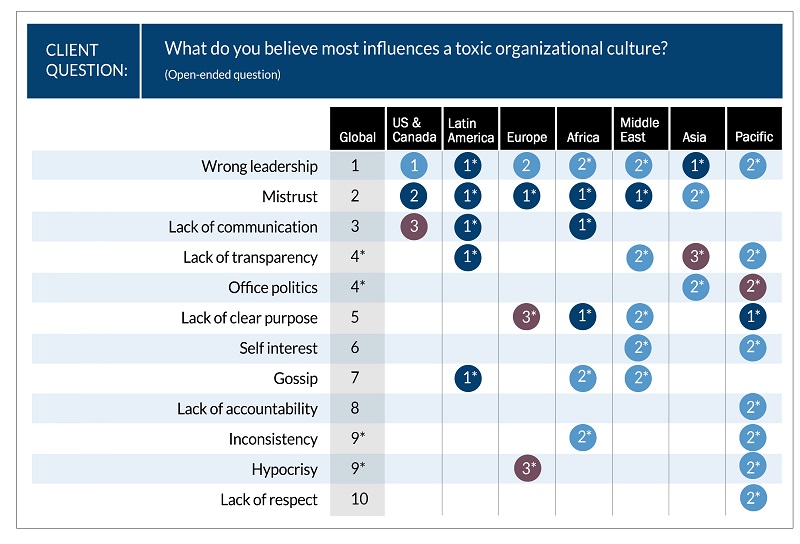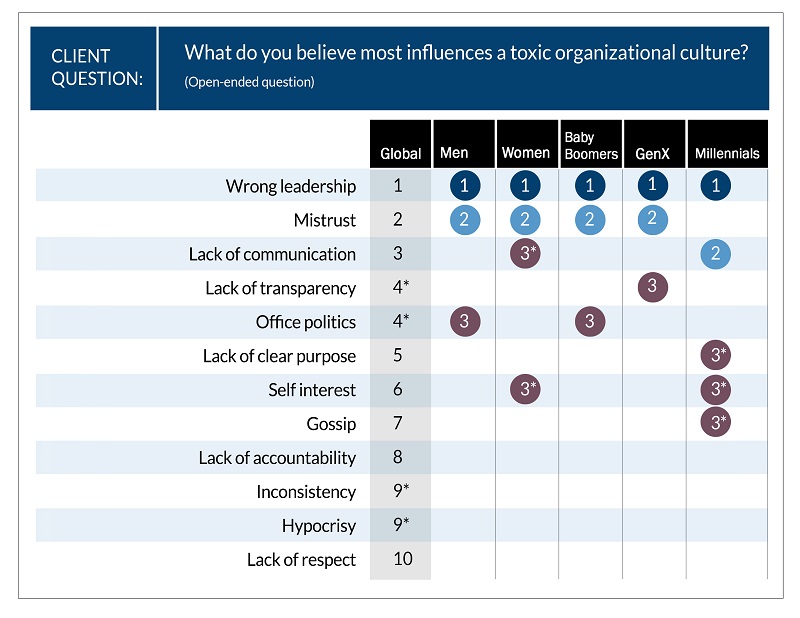
Blog
A toxic culture causes disengagement even with top talent. It stifles innovation and productivity and leads to high turnover. In a worst-case scenario, it could lead to the demise of the business. Unfortunately, there are signs that workplace toxicity may be on the rise. For example, a study last year by the Society for Human Resource Management found that 20% of people in the US have left a job in the past five years due to toxic workplace culture, and those losses have cost those companies more than 3B USD.
In our latest report Purpose. People. Progress., nearly 300 C-level business leaders across the globe cite ‘wrong leadership’ as the top reason for toxic work culture. This was true across responses by region and by demographic. Other responses included mistrust, lack of communication, lack of transparency, office politics, lack of clear purpose, self-interest, gossip, lack of accountability, inconsistency, hypocrisy, and lack of respect.
While the wrong leadership may be a top reason for toxic workplace culture, the problem may be what leadership is not doing as opposed to anything they are actively doing to create toxicity. This misstep is often a disconnect from their workforce and a lack of communication with their managers and teams.
Leadership Drives Workplace Culture
The main way to change a toxic work culture is by identifying it at its source. The right leadership makes a significant difference. In a separate question, the majority of clients identified that leaders who lead by example with a clear purpose are the key to an effective culture.
Inclusion needs more attention.
Clients ranked clear purpose, trust, customer-first mindset, and innovation in their top 10 elements of highly effective culture. Yet, we would have expected to see inclusion higher on the list. Not only are diversity and inclusion directly linked to innovation and stronger customer-centricity, but the next generation of executive talent also places a much greater emphasis on diverse and inclusive cultures. Belonging may be the key to retention, risk-taking, and engagement that launches an organization past the competition.
The COVID-19 pandemic has tested the limits of organizations. Business leaders have had the opportunity to witness emerging gaps in their talent-culture-strategy alignment. As leaders reassess their business models and their talent strategy for the post-pandemic environment, AESC Members can help them understand where they may be most at risk of coming up short and help guide them to solutions.
Leadership and transformation are top priorities and AESC Members are well-positioned to support organizations in creating a strong, diverse, innovative leadership team that can lead through a dramatic time of change.
For more insights on organizational culture and purpose-driven leadership, download the Purpose. People. Progress. report.
